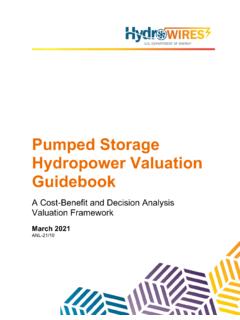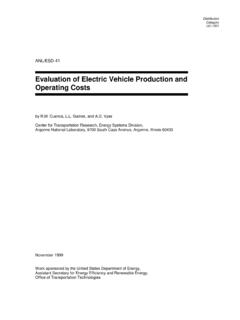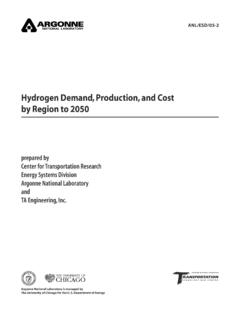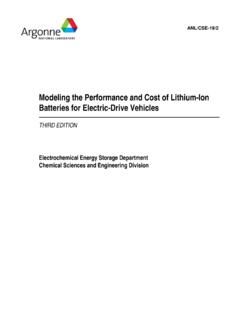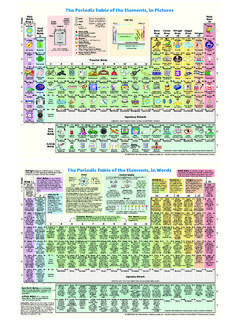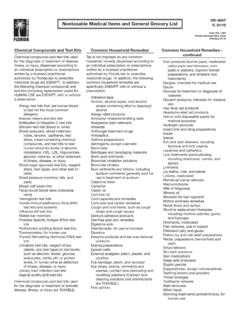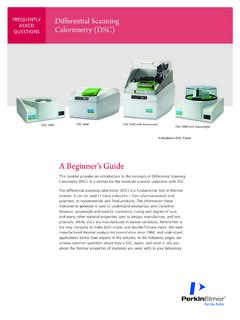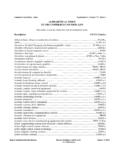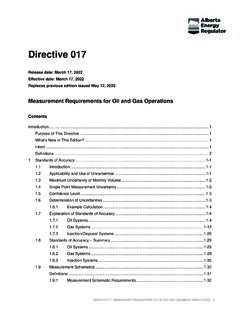Transcription of Technology Assessment of a Fuel Cell Vehicle: 2017 Toyota ...
1 Report # ANL/ESD-18/12 Technology Assessment of a Fuel Cell Vehicle: 2017 Toyota Mirai Energy Systems Division About Argonne National Laboratory Argonne is a Department of Energy laboratory managed by UChicago Argonne, LLC under contract DE-AC02-06CH11357. The Laboratory s main facility is outside Chicago, at 9700 South Cass Avenue, Argonne, Illinois 60439. For information about Argonne and its pioneering science and Technology programs, see DOCUMENT AVAILABILITY Online Access: Department of Energy (DOE) reports produced after 1991 and a growing number of pre-1991 documents are available free at ( ), a service of the US Dept. of Energy s Office of Scientific and Technical Information.
2 Reports not in digital format may be purchased by the public from the National Technical Information Service (NTIS): Department of Commerce National Technical Information Service 5301 Shawnee Rd Alexandria, VA 22312 Phone: (800) 553-NTIS (6847) or (703) 605-6000 Fax: (703) 605-6900 Email: Reports not in digital format are available to DOE and DOE contractors from the Office of Scientific and Technical Information (OSTI): Department of Energy Office of Scientific and Technical Information Box 62 Oak Ridge, TN 37831-0062 Phone: (865) 576-8401 Fax: (865) 576-5728 Email: Disclaimer This report was prepared as an account of work sponsored by an agency of the United States Government.
3 Neither the United States Government nor any agency thereof, nor UChicago Argonne, LLC, nor any of their employees or officers, makes any warranty, express or implied, or assumes any legal liability or responsibility for the accuracy, completeness, or usefulness of any information, apparatus, product, or process disclosed, or represents that its use would not infringe privately owned rights. Reference herein to any specific commercial product, process, or service by trade name, trademark, manufacturer, or otherwise, does not necessarily constitute or imply its endorsement, recommendation, or favoring by the United States Government or any agency thereof. The views and opinions of document authors expressed herein do not necessarily state or reflect those of the United States Government or any agency thereof, Argonne National Laboratory, or UChicago Argonne, LLC.
4 Report # ANL/ESD-18/12 Technology Assessment of a Fuel Cell Vehicle: 2017 Toyota Mirai prepared by Henning Lohse-Busch, Michael Duoba, Kevin Stutenberg, Simeon Iliev, Mike Kern Energy Systems Division, Argonne National Laboratory Brad Richards, Martha Christenson, Transport Canada Arron Loiselle-Lapointe, Environment and Climate Change Canada Prepared for Department of Energy, Fuel Cell Technologies Office June 2018 Technology ASSESSMENTOF A FUEL CELL Vehicle: 2017 Toyota MIRAIHENNING LOHSE-BUSCH, MICHAEL DUOBA, KEVIN STUTENBERG, SIMEON ILIEV, MIKE KERNA rgonne National LaboratoryReport ANL/ESD-18/12 June 2018 (v10)Argonne National Laboratory, RICHARDS, MARTHA CHRISTENSONT ransport Canada AARON LOISELLE-LAPOINTE Environment and Climate Change CanadaGOALS OF THE TESTINGThe technical objectives* of the Technology Assessment of this advanced production vehicle are to: Establish vehicle level energy consumption, efficiency, and performance data on varying drive cycles at ambient temperatures ranging from 20F to 95F with a stretch goal of testing a cold start at 0F.
5 Measure the performance envelops and synergies between the fuel cell system and the hybrid system (incl. fuel cell system idle). Generate an efficiency map of the fuel cell of a fuel cell production vehicle in a controlled laboratory environment* SOW_v5 submitted to FCTO in September 20172 OVERVIEWT esting of a fuel cell production vehicle in a controlled laboratory environment in order to generate public powertrain dataCollaboration with Transport Canada provided the vehicle and engaged in technical exchange of ideas. Argonne is very grateful for the successful collaboration. 3 Abbreviations used in the presentation: FC Fuel CellHEV Hybrid Electric VehicleBEV Battery Electric VehicleMpge Miles per gallon gasoline equivalentLe/100km Liter gasoline equivalent per 100 kilometersVehicle overview and instrumentation LinkFuel cell hybrid powertrain operation overview On cycles By componentsLinkFuel cell stack and system efficiency (steady load mapping)LinkCertification drive cycle testing and results at 72F Results with average efficiencies Energy analysisLinkFuel cell system operation Air & hydrogen as function of power output FC idle testing FC maximum power output (continuous and peak pulses) LinkImpact of temperatures.
6 0F, 20F, 72F and 95F+850W/m2 Fuel economy results and energy analysis ultsfor UDDS, Highway and US06 across temperatures Fuel cell system shut down from 72F to 0F Fuel cell system cold start from 72F to 0F Power delivery of FC conditioned at 0F Hill climb test at 95F with solar load LinkSummary and take away pointsLinkARGONNE VEHICLE Technology ASSESSMENTAND ANALYSIS REPORTING4 Vehicle level Energy consumption(fuel + electricity) Emissions Performance Vehicle operation and strategy In-situ component & system testing Component performance, efficiency, and operationover drive cycles Component mapping Test summary results 10Hz data of major signals Analysis Presentations2WD chassis dynamometer Up to medium dutyopened 2002, upgraded 2011opened 2009 We assess state-of-the-art transportation Technology for the Department of Energy and Argonne research interests Downloadable Dynamometer Database Oriented Test FacilitiesVehicle Technology Assessment4WD chassis dynamometer ThermalChamber.
7 0F to 95F Solar emulation5 VEHICLE OVERVIEW AND INSTRUMENTATION 2017 Toyota MIRAI FUEL CELL VEHICLE6*Manufacturer data + ^ Toyota Mirai Fuel Cell VehicleVehicle architectureFuel Cell Series HybridVehicleTest weight4250 lbsPowerplantFuel CellSolid Polymer ElectrolyteFuel Cell*370 cells in stack114kW*, kW/L, kW/kgFlow channel:3D fine-mesh flow field (cathode)Humidification:Internal circulation system (humidifier-less)Hydrogen storage10,000 psi, 5 kg of H2 BatteryNickel-metal Hydride, kWh, 245V *Climate controlElectrical AC compressorElectric heaterEPA LabelFuel Economy (mpge)66 City /66 Hwy /66 Combined+PerformanceReported 0-60 Time: ^ Toyota MIRAI POWERTRAIN COMPONENT LAYOUT7 The high voltage power distribution system is under the hood along with the inverters for the ElectronicsThe air cooled NiMH battery pack is packaged in the trunk similar to most Toyota Hybrid PackThe electric drive motor and the air compressor are packaged in-line between the front motorsThe fuel cell stack along with the boost converter is under the center of the vehicle.
8 Fuel Cell SystemThe two hydrogen tanks are under the trunk and the rear passenger seats. These tanks are disabled for the testing. On-board hydrogen MEASUREMENT FOR THE MIRAI8 Different metering technics:Integrated mass flow meter Yes Ideal gas law PossibleGravimetric NoOutside H2 StorageLaboratory grade hydrogen ( pure) in 12 packs with is equivalent to 6 gallons of gasoline. Hydrogen is piped into the building at 245 psi. Safety and Metering PanelThe hydrogen is metered by two Micro Motion ELITE Coriolis mass flow meters. The panel has over pressure safeties, automatic shut-off valves, hydrogen sensors and a venting system. Any hydrogen sensor can trigger the active test cell safeties and alert the fire department.
9 The vehicle hydrogen tanks are disabled and completely by-passed. The hydrogen is stepped down at the exit of the panel to 220 psi and fed into the pressure regulator in the middle of the cell ConnectionVehicle ConnectionNote:The 30 ft delivery hose and the vehicle piping between the mass flow meters and the fuel cell stack creates a filtering effect and time delay on the fuel flow measurement. but more complicated and not the intension of this worktoo expensive for the budget of this workPOWER MEASUREMENTS EQUIPMENTH ydrogen Flow:Micro Motion ELITE Coriolis meters Argonne s uses the CMF010M and CMF025M. gas flow accuracy; g/cc density accuracy The output of the meters is 4-20mA. The output on both meters is scaled from 4-20mA to 0-3gr/sec in the data acquisition system Further specifications: Power Flow:Hioki High Precision Power analyzer Hioki Power Analyzers PW3390-10 Hiokicurrent clamps: CT6841, CT6843 poweraccuracy Outputs (V, I, P, IH, WH) transferred to DAQ via ethernet.
10 V, I transfer via analog signal in additional to ethernet. Further Specifications: voltage tapPower analyzersCurrent clampsSAMPLE OF HIGHLIGHTED CAN MESSAGES (TOTAL 400+)10 Possible Vehicle Communication SignalValueUnitFC Voltage before Voltage after FC Output output Stack Air Temperature (FC Stack Inlet)38 CFC Stack. Air Pressure (FC Stack Inlet) (gauge)Intake Air Temperature26 CMass Air Flow Compressor Compressor Consumption Power0 WFC Stack Coolant Temperature (Radiator Outlet)29 CFC Stack Coolant Temperature (FC Stack Outlet)45 CFC Water Pump Water Pump Consumption Power19 VRadiator Fan 1 Driving Request0 %Radiator Fan 2 Driving Request0 %Estimated Radiator Rotary 'Valve Position0 %FC Stack Air Temperature (FC Stack Inlet)38 CFC Stack Air Pressure (FC Stack Inlet) (gauge)Mass Air Flow Pump Pump Consumption Power19 WSmoothed Value of Low-range Hydrogen (gauge)


